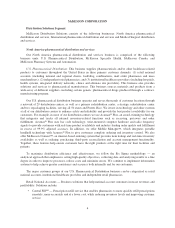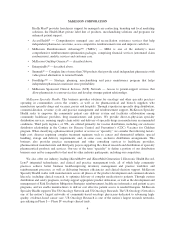McKesson 2015 Annual Report Download - page 19
Download and view the complete annual report
Please find page 19 of the 2015 McKesson annual report below. You can navigate through the pages in the report by either clicking on the pages listed below, or by using the keyword search tool below to find specific information within the annual report.McKESSON CORPORATION
multiple source generic drugs available for purchase by retail community pharmacies on a nationwide basis to a
limit of not less than 175% of the weighted average (determined on the basis of utilization) of the most recently
reported monthly average manufacturer price (“AMP”) using a smoothing process. The Centers for Medicare and
Medicaid Services (“CMS”) has proposed new rules for calculating AMP (“Revised AMP”) and is also offering
states the option to replace traditional reimbursement metrics for certain drugs with alternatives such as the
average acquisition cost (“AAC”) method or the national average drug acquisition cost benchmark (“NADAC”).
Under AAC and NADAC, reimbursement is based on the actual acquisition costs from invoiced amounts and
from a statistically validated cost of dispensing survey. States will have the option of using any of these metrics
to determine appropriate Medicaid reimbursement to pharmacies for generic or brand drugs. We expect that the
use of a Revised AMP benchmark or the use of an alternative reimbursement metric, such as AAC or NADAC,
would result in a reduction in the Medicaid reimbursement rates to our customers for certain pharmaceuticals,
which could indirectly impact the prices that we can charge our customers and cause corresponding declines in
our profitability.
The federal government may adopt measures that could reduce Medicare and/or Medicaid spending, or
impose additional requirements on healthcare entities. For example, under the terms of the Budget Control Act of
2011, an automatic 2% reduction of Medicare program payments for all healthcare providers became generally
effective for services provided on or after April 1, 2013. This automatic reduction is known as “sequestration.”
Medicare generally reimburses physicians for Part B drugs at the rate of average sales price (“ASP”) plus 6%.
The implementation of sequestration pursuant to the Budget Control Act of 2011 has effectively reduced
reimbursement below the ASP plus 6% level for the duration of sequestration (which lasts through fiscal 2024 in
the absence of additional legislation). As another example, the Medicare Access and CHIP Reauthorization Act
(“MACRA”), signed into law in April 2015, seeks to reform Medicare reimbursement policy for physician fee
schedule services and adopts a series of policy changes affecting a wide range of providers and suppliers. Most
notably, MACRA repeals the statutory Sustainable Growth Rate formula, which has called for cuts in Medicare
rates in recent years, but which Congress routinely stepped in to override the full application of the formula.
Instead, after a period of stable payment updates, MACRA links physician payment updates to quality and value
measurements and participation in alternative payment models. MACRA also extends certain expiring Medicare
and other health policy provisions, including extending the Children’s Health Insurance Program. Additionally,
concerns held by federal policymakers about the federal deficit and national debt levels could result in enactment
of further federal spending reductions, further entitlement reform legislation affecting the Medicare program, or
both. We cannot predict what alternative or additional deficit reduction initiatives or Medicare payment
reductions, if any, will ultimately be enacted into law, or the timing or affect any such initiatives or reductions
will have on us.
There can be no assurance that the preceding changes would not have a material adverse impact on our
results of operations.
Operating, Security and Licensure Standards: We are subject to the operating and security standards of the
Drug Enforcement Administration (“DEA”), the U.S. Food and Drug Administration (“FDA”), various state
boards of pharmacy, state health departments, the U.S. Department of Health and Human Services (“HHS”), the
CMS and other comparable agencies. Certain of our businesses may be required to register for permits and/or
licenses with, and comply with operating and security standards of the DEA, FDA, HHS, CMS, various state
boards of pharmacy, state health departments and/or comparable state agencies as well as foreign agencies and
certain accrediting bodies, depending upon the type of operations and location of product development,
manufacture, distribution, and sale. For example, we are required to hold valid DEA and state-level registrations
and licenses, meet various security and operating standards and comply with the Controlled Substances Act and
its accompanying regulations governing the sale, marketing, packaging, holding and distribution of controlled
substances.
14
























